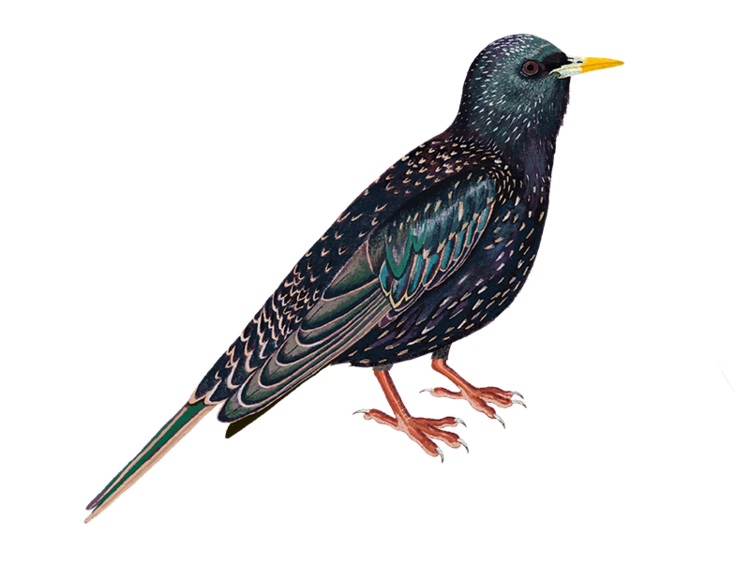Birds
Common blackbird a.k.a. Raven
The Raven is commonly found in open areas such as tundras, taigas, cliffs, deserts, plains, and just about every habitat except for rainforests. They are known for their intelligence and can live between 13 and 44 years. Often associated with loss and an omen, due to the notable poem, the Raven by Edgar Allen Poe, Ravens are talkers and scavengers. They are effective hunters that sometimes use cooperative techniques and contribute to recycling nutrients into the ecosystem by eating the carcasses of dead animals.
Common Chiffchaff
A ChiffChaff is a leaf warbler found in woodlands throughout northern Europe and the Palearctic. It migrates in winters to southern and western Europe, Southern Asia, and North Africa. It eats insects from trees and can be seen flying out to snap them up in flight.
Starling
Starlings are highly social birds that are commonly found in Europe, Asia, Africa, Australia, and the Pacific Islands. They have a shimmering, iridescent black-green-and-purple plumage, dotted with light speckles that mimics a starry night sky. They eat moths and caterpillars, flies and fly larvae, and many other insects. Fun fact: They are master mimics—they can reproduce the sounds of humans, other birds, and inanimate objects.
Common Swift
Swifts are among the fastest of birds in level flight and can cruise at a maximum speed of 31 meters per second. Often mistaken for swallows, they are typically found in most parts of the world, except the Polar regions, southern Chile, Argentina, New Zealand and Australia. They typically spend their lives in the air, eating, sleeping and even bathing.
Eurasia Hoopoe
A vibrantly-colored tropical bird with a Mohican feathered top is known as a hoopoe. They are known for their distinctive zebra-striped wings and bright orange head crest. Usually found across Africa and southern Europe, they have an impressive wing span allowing them to travel long distances. They typically eat seeds, insects, and small reptiles.
Eurasian Collared Dove
The Eurasian collared dove is a dove species native to Europe and Asia. Because of its vast global range and increasing population trend, it has been listed as Least Concern on the IUCN Red List since 2014. Eurasian collared doves do not migrate and live in towns and cities, in urban gardens and parks. In their original range, they typically occur in semi-desert regions with scattered trees, or mixed thickets and orchards.
Fulvous-Babbler
Found most often in forest and scrub in southeast Asia and the Indian subcontinent range including Bangladesh, Pakistan, and Nepal. Most often brownish in color the legs of these birds are strong. Males and females tend to have a few differences only. They are also known to be noisy creatures.
House-Bunting
These birds are mostly found in North Africa, which includes Morocco. They are omnivorous and feed on both plants and animals. Though seeds are a part of their diet, these tiny birds are capable hunters and are known to hunt and prey on small insects and spiders.
House-Sparrow
The House Sparrow takes frequent dust baths. It throws soil and dust over its body feathers, just as if it were bathing with water. In doing so, a sparrow may make a small depression in the ground, and sometimes defends this spot against other sparrows. The House Sparrow prefers to nest in manmade structures such as eaves or walls of buildings, streetlights, and nest boxes instead of in natural nest sites such as holes in trees.
Maghreb-Magpie
The magpie of North Africa; is very similar to the Eurasian Magpie and closely related. Slightly shorter-winged and longer-tailed than Eurasian Magpie with blue bare skin around the eye. Also lacks gloss on the tail. Found in various wooded habitats including urban and suburban gardens, woodlands, cultivated areas, and forests. The call is a rapid chatter and is slightly higher pitched than that of Eurasian Magpie.
African Pied Wagtail
The only black-and-white wagtail in Africa shows a bold white eyebrow and wing panels and a broad black throat patch. The juvenile is brownish. Pairs and family groups frequent a broad range of habitats, including human-altered environments, but in drier areas, they are associated with waterside habitats. The species runs on the ground foraging for insects, characteristically wagging its tail up and down in an exaggerated motion.
Putter-European-Gold-Finch
Beautiful little finch with a sharp pink bill, cherry-red face, and brilliant black-and-yellow flashes in the wings. Uses a wide array of wooded and open habitats, from forests and gardens to steppe grasslands and meadows; often feeds on seeding thistles.
Spanish Sparrow
Also known as Willow Sparrows found in the Mediterranean region and south-west and central Asia. They are decreasing in population. They are often mistaken for House Sparrows. The males have a heavily streaked black breast and back and a rufous crown and nape. Females can be difficult to separate from female House Sparrows but have bigger bills and paler bellies.
Western-Cattle-Egret
Small, compact white heron with a relatively short yellow bill. More frequently seen in dry habitats than other egrets; rarely gets its feet wet. What do cattle egrets do for cattle?
The cattle egret removes ticks and flies from cattle and consumes them. This benefits both species, the relationship between a cattle egret and a cow is called mutualism because both benefits from the relationship and neither is harmed by the relationship.
White-Wagtail
The White wagtail is a small insectivorous bird of the open country, often near habitation and water. It prefers bare areas for feeding, where it can see and pursue its prey. In urban areas, it has adapted to foraging on paved areas such as car parks. It is the national bird of Latvia and has featured on the stamps of several countries.
Wood Pigeon
A large member of the Dove and Pigeon family. Inhabits wooded and semiopen habitats, including towns and gardens. Forms flocks, especially in winter. Often rather unaware, and frequently crashes noisily and clumsily out of hedges and bushes. Found in Europe, Asia, and Africa. Common wood pigeons are gregarious, often forming very large flocks outside the breeding season.
European Pied Flycatcher
These birds breed all over Europe and parts of Northern Africa. Females and immature males are two tones of brown, while breeding males mature to become jet black on their backs. Both sexes have a white underbelly, females tend to be more dull and dusty in color. The males of this species are often polygamous and have separate territories for their separate mates and offsprings.
Eurasian Sparrowhawk
A small long-tailed hawk, with rounded wings, and notable yellow eyes. They do not soar often, mostly seen darting for quick hunting flights. They are brown with horizontal striped underparts. They are seen in woodland, forests, farmlands, gardens, and sometimes urban areas with wooded areas to hide. They are habitants of Europe, and scattered throughout parts of Asia and Northern Africa.


















